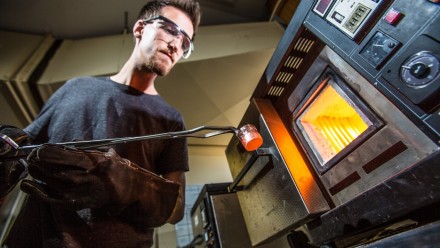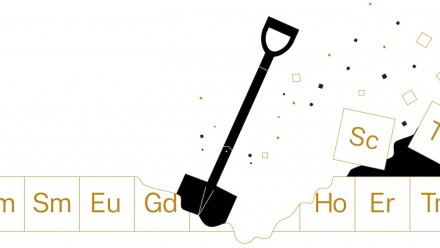Experimental Petrology
The Experimental Petrology group uses a laboratory-based experimental approach combined with field observations to study the Earth, its origin, evolution and mineral wealth. The group operates a wide range of experimental devices for generating the high temperatures and pressures that are needed to reproduce the natural conditions within the Earth.
The equipment includes:
- High temperature furnaces capable of reaching 1800 ⁰C, equipped for precise control of oxygen and sulphur fugacities by gas mixing;
- Eleven solid-media piston-cylinder devices for generating pressures to 6 GPa and temperatures in excess of 2000 ⁰C;
- A multi-anvil apparatus for achieving pressures of 26 GPa;
- A well-equipped hydrothermal laboratory.
The group has access to and expertise in an array of microbeam analytical techniques, including:
- JEOL 8530F Plus electronprobe microanalyser (hosted in the Centre for Advanced Microscopy, CAM)
- Various scanning electron microscopes and a QEMScan (CAM)
- Laser-ablation ICP-MS for trace element and isotopic analysis;
- FTIR spectroscopy for the determination of H₂0, CO₂ and other volatile species in minerals and glasses;
- X-ray fluorescence microscopy and X-ray absorption spectroscopy at various synchrotron facilities
Leader
Researchers
- Associate Professor Olivier Alard
- Dr Michael Anenburg
- Dr Antony Burnham
- Dr Joëlle D'Andres
- Tobias Gruetzner-Handke
- Professor John Mavrogenes
- Dr Seann McKibbin
- Dr Laura Miller
- Dr Zachary Sudholz
- Professor Greg Yaxley
Research support officer
Students
- Jemi Ahnaf
- Ramkumar Arcot Parthiban
- Yamila Cajal Contreras
- Carlos Carrasco-Godoy
- Ross Chandler
- Rodrigo Antonio De Freitas Rodrigues
- Yajie Gao
- Shao-Chen (Oliver) Hsu
- Zhijie Huang
- Christopher Ingles
- Timothy Leong
- Christina Loidolt
- Alana Mina
- Rosmalia Nugraheni
- Bozana Pasic
- Srijita Ray
- Erios Sembatya
- Catherine Wilsbacher
- Tao Ye
Visitors and affiliates
| Project | Status |
|---|---|
| Critical metals in tin deposits | Potential |
| Experimental Petrology | Potential |
| Geothermometry of regional alteration assemblages from the greater McArthur Basin | Potential |
| How do carbonatites form deposits of niobium? | Potential |
| Ore geology | Potential |
| The age and tectonic setting of basaltic intrusions of the south coast of NSW | Potential |
| The geochemistry of the platinum group element in ore bearing and barren granitoid suites. | Current |
| The timing of extreme metamorphism | Current |
| Trace element and volatile recycling in subduction zones | Current |
| Water in the mantle | Current |
| Zircon and monazite in granites | Potential |
| Zircon and monazite trace element partitioning | Current |
- Campbell, I. H., O'Neill H. St. C. (2012) Evidence against a chondritic Earth. Nature, 483: 553-558, DOI 10.1038/nature10901.
- Campbell, I.H. and Griffiths, R.W. (1990) Implications of mantle plume structure for the evolution of flood basalts. Earth Planet. Sci. Lett. 99: 79-93.
- Campbell, I.H., Griffiths, R.W. and Hill, R.I. (1989) Melting in an Archaean mantle plume: heads it's basalts, tails it's komatiites. Nature. 339: 697-699..
- Campbell, I.H. and A.J. Naldrett. (1979) The influence of silicate: sulfide ratios on the geochemistry of magmatic sulfides. Econ. Geol., 74, 1503-1506.
- Campbell, I.H., Naldrett, A.J. and Barnes, S.J. (1983) A model for the origin of the platinum-rich sulfide horizons in the Bushveld and Stillwater Complexes. J. Petrol. 24: 133-165.
- Cox, S.F., 2005. Coupling between deformation processes, fluid pressures and fluid flow in ore-producing hydrothermal environments. Economic Geology, 1200th Anniversary volume, 39 - 75.
- Cox, S.F., 2007. Structural and isotopic constraints on fluid flow regimes and fluid pathways during upper crustal deformation: An example from the Taemas area of the Lachlan Orogen, SE Australia, Journal of Geophysical Research, 112, B08208, doi:10.1029/2006JB004734.
- Cox, S.F., 2010. The application of failure mode diagrams for exploring the roles of fluid pressure and stress states in controlling styles of fracture-controlled permeability enhancement in faults and shear zones. Geofluids, 10 (1-2), 217-233. doi:10.1111/j.1468-8123.2010.00281.x.
- Arndt, M., Virgo, S., Cox, S.F. & Urai, J.L., accepted. Changes in fluid pathways in a calcite vein mesh (Natih Formation, Oman Mountains): Insights from stable isotopes. Geofluids. in press.
- Jenner FE, O’Neill HSC, Arculus RJ and Mavrogenes JA (2010) The magnetite crisis in the evolution of arc-related magmas and the initial concentration of Au, Ag and Cu. Journal of Petrology, v. 51, p. 2445-2464.
- Peterson EC and Mavrogenes JA (2014) Linking high-grade gold mineralisation to earthquake-induced fault-valve processes in the Porgera gold deposit, Papua New Guinea. Geology, published online March 17, DOI: 10.1130/G35286.1
- Mavrogenes JA, Henley RW, Reyes AC, Berger B (2010) Sulfosalt melts: evidence of high temperature vapor transport of metals in the formation of high sulfidation lode gold deposits. Economic Geology, v. 105, p. 257-262.
- Mavrogenes, JA and O'Neill, HS (1999) The relative effects of pressure, temperature and oxygen fugacity on the solubility of sulfide in mafic magmas. Geochimica et Cosmochimica Acta, v. 63, p. 1173-1180
- Loucks, RR and Mavrogenes, JA (1999) Gold solubility in supercritical hydrothermal brines measured in synthetic fluid inclusions. Science, v. 284, p. 2159-2163.











